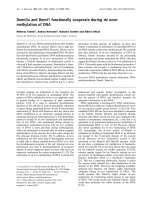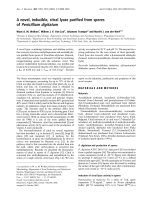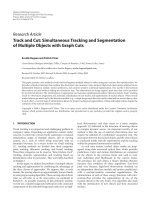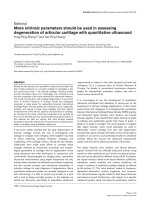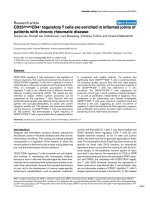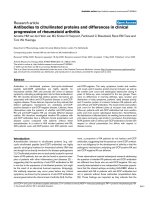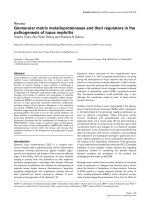Báo cáo y học: "More intrinsic parameters should be used in assessing degeneration of articular cartilage with quantitative ultrasound" doc
Bạn đang xem bản rút gọn của tài liệu. Xem và tải ngay bản đầy đủ của tài liệu tại đây (44.03 KB, 3 trang )
Page 1 of 3
(page number not for citation purposes)
Available online />Abstract
During the last decade, the quantitative ultrasound technique has
been widely employed as a versatile modality to investigate a thin
but crucial tissue layer – the articular cartilage. Previous studies
provide information about the morphology and mechanical and
acoustic properties of the tissue derived from ultrasound measure-
ments and correlate them with cartilage degeneration. In a previous
issue of Arthritis Research & Therapy, Kuroki and colleagues
presented a study about the relationship between International
Cartilage Repair Society grading and ultrasound echo magnitude,
duration, and interval in human knee cartilage. We think indirect
measurements of the intrinsic physical characteristics of cartilage,
as reported in this study, should be interpreted more carefully as
they can be affected by many experimental and physical factors. In
this editorial, we offer our opinion that more intrinsic material
parameters should be selected for the assessment of degeneration
states of cartilage using quantitative ultrasound.
It has been widely reported that the early degeneration of
articular cartilage involves the loss of proteoglycan and
damage of collagen matrix integrity, which together may lead
to tissue softening, swelling, thickness changing and
roughening of the cartilage surface. During the last decade,
researchers have made many efforts to correlate these
changes reflected by mechanical, acoustical, and morpho-
logical parameters of cartilage with its degeneration levels
using ultrasound and other techniques. In comparison with
conventional ultrasonography for imaging joints, quantitative
ultrasound measurements using higher frequencies not only
achieve better resolution for thickness and surface roughness
but also provide acoustic and mechanical parameters of
articular cartilage for early diagnosis of degeneration. Since
quantitative ultrasound probes are normally designed to use
with arthroscopy, it is able to access any location of a joint
with a cost of being minimally invasive. In this editorial, we
limited our discussion specifically to quantitative ultrasound
measurement in relation to the work reported by Kuroki and
colleagues [1] in a previous issue of Arthritis Research &
Therapy. For details of conventional noninvasive ultrasono-
graphy for osteoarthritis evaluation, readers may refer to
recent review articles [2-4].
It is encouraging to see the development of quantitative
ultrasound techniques from laboratory to clinical use for the
assessment of articular cartilage degeneration. In their recent
study, Kuroki and colleagues [1] investigated the correlations
between International Cartilage Repair Society (ICRS) grading
and ultrasound signal intensity, echo duration, and interval
between signals. It was reported that ‘signal intensity of grade
0 cartilage was significantly greater than those of grade 1,
grade 2, or grade 3 cartilage’. The result appears to suggest
that ‘signal intensity’ alone could potentially be used to
differentiate normal cartilage from that with degeneration
provided that signal intensity information of the normal state is
available. In our opinion, such potentials should be considered
carefully, taking into account the ultrasound measurement
system and the intrinsic physical properties of the tissue.
The ‘signal intensity, echo duration, and interval between
signals’ derived from the reflected ultrasound echoes using
wavelet or other methods are not intrinsic mechanical proper-
ties and can be affected by different factors [5,6]. In physics,
the ‘signal intensity’ relates to the tissue reflection coefficient,
impedance, elastic modulus, and surface conditions, not
simply ‘a measure of superficial cartilage integrity’ as defined
by the authors [1]. The ‘echo duration’ relates to frequency-
dependent attenuation, surface roughness, and curvature.
The ‘interval between signals’ relates to both tissue thickness
and speed of sound. Furthermore, with respect to a specific
ultrasound system setup (including the parameters used for
Editorial
More intrinsic parameters should be used in assessing
degeneration of articular cartilage with quantitative ultrasound
Yong-Ping Zheng
1,2
and Yan-Ping Huang
1
1
Department of Health Technology and Informatics, The Hong Kong Polytechnic University, Kowloon, Hong Kong, China
2
Research Institute of Innovative Products and Technologies, The Hong Kong Polytechnic University, Kowloon, Hong Kong, China
Corresponding author: Yong-Ping Zheng,
Published: 16 December 2008 Arthritis Research & Therapy 2008, 10:125 (doi:10.1186/ar2566)
This article is online at />© 2008 BioMed Central Ltd
See related research by Kuroki et al., />ICRS = International Cartilage Repair Society.
Page 2 of 3
(page number not for citation purposes)
Arthritis Research & Therapy Vol 10 No 6 Zheng and Huang
pulser/receiver and focusing of transducer), signal intensity is
also sensitive to the distance between the transducer and
tissue, orientation of the transducer (incidence angle of ultra-
sound beam), and curvature of the tissue surface besides the
tissue state. The echo duration can be affected by the
characteristics of ultrasound transducer, such as its fre-
quency response and beam width, and those of pulser/
receiver, such as pulse duration, filter setting, and damping.
Therefore, unless all affecting factors can be controlled and
standardized, even a significant correlation between ultra-
sonic parameters and clinical grades obtained by a specific
device might provide limited information.
Furthermore, this study used ‘interval between signals’ to
correlate with ICRS grades, making the result difficult to
interpret because the speed of sound and the thickness both
can contribute to the change of the interval. Although the
authors did discuss the effect of swelling on the speed of
sound, they neglected to address the fact that thickness
could also be affected during swelling. If these intrinsic
physical properties are reported, comparison of results from
different specimens, species, devices, and investigative
approaches would become more feasible and meaningful.
The making of assumptions, which are used as the basis for
obtaining the intrinsic physical properties, is inevitable.
Knowing what assumptions were made helps researchers to
anticipate or know what possible factors may affect the
results. This in turn will promote better understanding of the
assumptions and factors involved, which leads to the
development of new approaches.
Instead of using ‘signal intensity’, a number of papers have
reported the use of ultrasound reflection coefficient [7],
integrated reflection coefficient [8], and echo frequency
spectrum [9] to assess cartilage degeneration. To provide a
better thickness measurement using ultrasound, researchers
have made efforts to investigate the depth dependency of
speed of sound [10] and techniques for measuring speed of
sound in situ [11]. To quantify the surface roughness directly, a
new method using ultrasound scanning has been proposed
[12]. Ultrasound has been used along with mechanical
disturbance methods, such as indentation [7,13], water jet
indentation [14], compression [15], or osmosis loading [16], to
measure more intrinsic mechanical properties and their depth
dependency. Some of these techniques may not yet be ready
for clinical trials, but they can provide valuable fundamental
information to drive development forward, with the ultimate aim
of providing reliable clinical tools for early diagnosis of
osteoarthritis. Readers may refer to Wang and colleagues [17]
for a more comprehensive list of related references.
In summary, while quantitative ultrasound has demonstrated
promising potential in assessing cartilage degeneration, an
understanding of its physical principles and limitations is
necessary. We suggest that engineers in the field aim to
develop new techniques to obtain intrinsic physical para-
meters of cartilage. We also hope that clinicians in the field
(or through collaboration with their engineer colleagues) fully
understand the physical principles of the measurement and
what the obtained parameters physically represent before
trying to interpret the data and look for correlations. The
success of quantitative ultrasound for bone mineral density
assessment should be attributed in part to its direct
measurement of intrinsic physical parameters, including
speed of sound and attenuation [18], which made cross-
center comparison and instrumentation standardization
possible. We believe only quantitative ultrasound assessment
using more intrinsic physical parameters can lead to reliable
clinical devices for early evaluation of osteoarthritis. Finally,
we commend Kuroki and colleagues for demonstrating to us
the use of a miniaturized probe with simplified data inter-
pretation for clinical trials. No doubt, advancement based on
this work will ensue.
Competing interests
The first author holds 3 patents that can be potentially used
for the assessment of articular cartilage:
1. Zheng YP and Choi APC. Measurement of modulus and
Poisson's ratio simultaneously from indentation. US
Provisional Patent Application. No. 60/580,679. Chinese
patent filed. 200610077789.6. Apr 2006.
2. Mak AFT and Zheng YP, Portable ultrasound palpation
device. US Patent issued, No. 6494840, Dec 2002.
3. Zheng YP and Lu MH, Noncontact measurement of
material properties. US patent issued. No. 7124636. Oct
24 2006
Acknowledgments
The works of the authors in the field of ultrasound assessment for artic-
ular cartilage were supported in part by The Hong Kong Research
Grant Council (F-HK12/01T, PolyU5199/02E, PolyU5245/03E, and
PolyU5318/05E) and The Hong Kong Polytechnic University (J-BB69).
References
1. Kuroki H, Nakagawa Y, Mori K, Kobayashi M, Yasura K, Okamoto
Y, Suzuki T, Nishitani K, Nakamura T: Ultrasound properties of
articular cartilage in the tibio-femoral joint in knee osteo-
arthritis: relation to clinical assessment (ICRS grade). Arthritis
Res Ther 2008, 10:R78.
2. Chao J, Kalunian K: Ultrasonography in osteoarthritis: recent
advances and prospects for the future. Curr Opin Rheumatol
2008, 20:560-564.
3. Moller I, Bong D, Naredo E, Filippucci E, Carrasco I, Moragues C,
Iagnocco A: Ultrasound in the study and monitoring of
osteoarthritis. Osteoarthritis Cartilage 2008, 16 Suppl 3:S4-S7.
4. Meenagh G: Ultrasound imaging for the rheumatologist – VIII.
Ultrasound imaging in osteoarthritis. Clin Exp Rheumatol
2007, 25:172-175.
5. Saarakkala S, Jurvelin JS, Zheng YP, Nieminen HJ, Toyras J:
Quantitative information from ultrasound evaluation of articu-
lar cartilage should be interpreted with care. Arthroscopy
2007, 23:1137-1138.
6. Kaleva E, Saarakkala S, Toyras J, Nieminen HJ, Jurvelin JS: In vitro
comparison of time-domain, frequency-domain and wavelet
ultrasound parameters in diagnostics of cartilage degenera-
tion. Ultrasound Med Biol 2008, 34:155-159.
7. Laasanen MS, Toyras J, Hirvonen J, Saarakkala S, Korhonen RK,
Nieminen MT, Kiviranta I, Jurvelin JS: Novel mechano-acoustic
technique and instrument for diagnosis of cartilage degenera-
tion. Physiol Meas 2002, 23:491-503.
Page 3 of 3
(page number not for citation purposes)
8. Cherin E, Saied A, Laugier P, Netter P, Berger G: Evaluation of
acoustical parameter sensitivity to age-related and
osteoarthritic changes in articular cartilage using 50-MHz
ultrasound. Ultrasound Med Biol 1998, 24:341-354.
9. Brown CP, Hughes SW, Crawford RW, Oloyede A: Ultrasound
assessment of articular cartilage: analysis of the frequency
profile of reflected signals from naturally and artificially
degraded samples. Connect Tissue Res 2007, 48:277-285.
10. Patil SG, Zheng YP, Shi J: Measurement of depth-dependence
and anisotropy of ultrasound speed of bovine articular carti-
lage in vitro. Ultrasound Med Biol 2004, 30:953-963.
11. Suh JK, Youn I, Fu FH: An in situ calibration of an ultrasound
transducer: a potential application for an ultrasonic indenta-
tion test of articular cartilage. J Biomech 2001, 34:1347-1353.
12. Saarakkala S, Toyras J, Hirvonen J, Laasanen MS, Lappalainen R,
Jurvelin JS: Ultrasonic quantitation of superficial degradation
of articular cartilage. Ultrasound Med Biol 2004, 30:783-792.
13. Zheng YP, Mak AF: An ultrasound indentation system for bio-
mechanical properties assessment of soft tissues in vivo.
IEEE Trans Biomed Eng 1996, 43:912-918.
14. Lu MH, Zheng YP, Huang QH, Ling C, Wang Q, Bridal L, Qin L,
Mak A: Noncontact evaluation of articular cartilage degenera-
tion using a novel ultrasound water jet indentation system.
Ann Biomed Eng 2008 Nov 15. [Epub ahead of print].
15. Zheng YP, Mak AF, Lau KP, Qin L: An ultrasonic measurement
for in vitro depth-dependent equilibrium strains of articular
cartilage in compression. Phys Med Biol 2002, 47:3165-3180.
16. Wang Q, Zheng YP, Leung G, Lam WL, Guo X, Lu HB, Qin L,
Mak AF: Altered osmotic swelling behavior of proteoglycan-
depleted bovine articular cartilage using high frequency ultra-
sound. Phys Med Biol 2008, 53:2537-2552.
17. Wang Q, Zheng YP, Qin L, Huang QH, Lam WL, Leung G, Guo
X, Lu HB: Ultrasonic assessment of progressive proteoglycan
depletion of articular cartilage in real-time. Ultrasound Med
Biol 2008, 34:1085-1092.
18. Njeh CF, Boivin CM, Langton CM: The role of ultrasound in the
assessment of osteoporosis: a review. Osteoporosis Int 1997,
7:7-22.
Available online />

